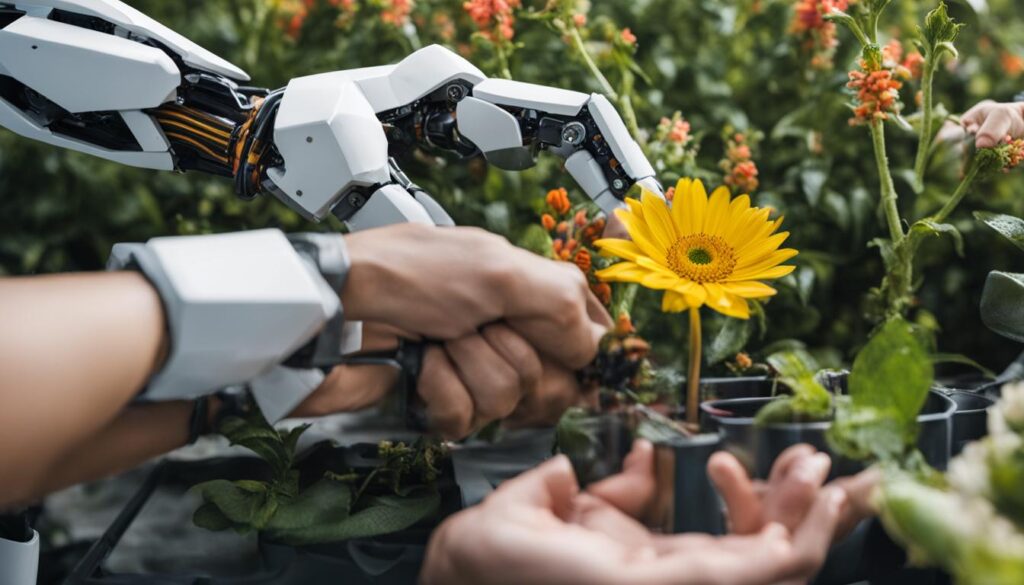Were you aware that multiple types of AI exist? Ranging from machines capable of surpassing human abilities in particular areas to hypothetical versions of AI endowed with consciousness, the realm of artificial intelligence is broad and continuously growing.
In this article, we will delve into the different types of AI, exploring their capabilities, functionalities, and potential applications. Whether you are a tech enthusiast or simply curious about the future of AI, understanding these different types can give you a glimpse into the exciting possibilities that lie ahead.
Key Takeaways:
- AI encompasses various types, including Narrow AI, General AI, Super AI, Reactive Machines, Limited Memory AI, Theory of Mind AI, and Self-aware AI.
- The main categories of AI are based on capabilities (Narrow AI, General AI, Super AI) and functionalities (Reactive Machines, Limited Memory AI, Theory of Mind AI).
- Narrow AI is the only type of AI currently existing, with examples such as virtual assistants and recommendation systems.
- General AI and Super AI are still theoretical concepts with human-like intelligence and superhuman capabilities.
- Reactive Machines, Limited Memory AI, Theory of Mind AI are functional classes of AI with different levels of memory and understanding of human emotions.
Overview of AI Categories and Functionalities
When it comes to artificial intelligence (AI), understanding its categories and functionalities is essential. AI can be classified based on its capabilities and the tasks it can perform. Let’s take a closer look at the main AI categories and functionalities:
AI Categories:
- Narrow AI: Also known as Weak AI or Artificial Narrow Intelligence, Narrow AI focuses on specific tasks and lacks the ability to generalize beyond its intended purpose. Examples of Narrow AI include virtual assistants like Siri and AI-powered recommendation systems like Netflix’s.
- General AI: Also referred to as Strong AI or Artificial General Intelligence, General AI possesses human-like intelligence and the ability to perform multiple tasks. It can learn and adapt without human intervention. However, General AI remains a theoretical concept and has not been fully realized yet.
- Super AI: Super AI, or Artificial Superintelligence, surpasses human intelligence and possesses cognitive abilities beyond human capabilities. It is still in the realm of theory and development, envisioned with its own emotions, needs, and beliefs.
AI Functionalities:
- Reactive Machines: Reactive Machines are AI systems that lack memory and make decisions based solely on the current data. They utilize machine learning models to analyze data and provide intelligent outputs. Examples of Reactive Machines include IBM’s Deep Blue, which defeated chess grandmaster Garry Kasparov, and Netflix’s recommendation engine.
- Limited Memory AI: Limited Memory AI is capable of recalling past events and outcomes, leveraging past data to make informed decisions. It uses deep learning algorithms and improves its performance over time. Self-driving cars and virtual assistants are examples of Limited Memory AI.
- Theory of Mind AI: Theory of Mind AI aims to understand the thoughts and emotions of other entities. This functional class of AI simulates human-like relationships and personalizes interactions based on individual emotional needs. However, it is still in the theoretical and developmental stages.
Now that we have examined the main categories and functionalities of AI, it’s clear that AI encompasses a wide range of capabilities and purposes. The advancements and possibilities in the field of AI continue to expand, shaping the future of technology and its impact on society.

| AI Categories | AI Functionalities |
|---|---|
| Narrow AI (Weak AI or Artificial Narrow Intelligence) | Reactive Machines |
| General AI (Strong AI or Artificial General Intelligence) | Limited Memory AI |
| Super AI (Artificial Superintelligence) | Theory of Mind AI |
Narrow AI (Artificial Narrow Intelligence)
When it comes to the current state of AI, Narrow AI takes center stage. Also known as Artificial Narrow Intelligence, this type of AI focuses on performing specific tasks with precision and efficiency. While it may seem limited compared to the concept of General AI, Narrow AI serves a valuable purpose in various applications.
Narrow AI is designed to excel in a specific domain and lacks the ability to go beyond its intended purpose. It is highly specialized and optimized to perform tasks within a narrow range of functionalities. This level of specificity allows for greater accuracy and reliability in achieving desired outcomes.
Examples of Narrow AI can be seen in our everyday lives. Virtual assistants like Siri, Alexa, and Google Assistant rely on Narrow AI technologies to provide users with convenient and personalized experiences. These AI-powered systems can understand and respond to voice commands, provide information, and perform tasks such as setting reminders, playing music, and even controlling smart home devices.

“Narrow AI is like having a trusted assistant who excels in specific fields. It may not possess the breadth of knowledge or consciousness, but it gets the job done with accuracy and efficiency.”
Narrow AI is also prevalent in recommendation systems used by major platforms such as Netflix, Amazon, and Spotify. These AI-powered algorithms analyze user behavior and preferences to deliver personalized recommendations for movies, products, and music. By understanding patterns and trends, Narrow AI can suggest content that aligns with an individual’s interests, enhancing the overall user experience.
While Narrow AI may not have the cognitive capabilities of General AI or Super AI, its practical applications and efficiency make it an invaluable tool across various industries. From healthcare and finance to customer service and entertainment, Narrow AI continues to revolutionize the way we interact with technology.
| Industry | Applications |
|---|---|
| Healthcare | Medical image analysis, disease diagnosis, drug discovery |
| Finance | Algorithmic trading, fraud detection, risk assessment |
| Customer Service | Chatbots, virtual assistants, voice recognition |
| Entertainment | Recommendation systems, content generation, gaming |
Benefits of Narrow AI
- Improved efficiency and accuracy in specific tasks
- Personalized user experiences
- Enhanced decision-making capabilities
- Automation of repetitive and time-consuming processes
- Streamlined operations and cost reduction
Challenges of Narrow AI
- Limitations in understanding context and complex human emotions
- Potential biases in algorithms if not properly trained and monitored
- Dependency on large amounts of data for effective performance
- Limited ability to generalize knowledge and adapt to new situations
- Potential security and privacy concerns
As AI technology continues to advance, Narrow AI acts as the foundation for further developments in the field. It forms the basis for building more sophisticated AI systems, pushing the boundaries of what AI can achieve in the future.
General AI (Artificial General Intelligence)
General AI, also known as Artificial General Intelligence (AGI), refers to the development of AI systems that possess human-like intelligence and can perform a wide range of tasks. Unlike Narrow AI, which is designed for specific purposes, General AI aims to replicate human cognitive abilities and adapt to various situations without human intervention. While Narrow AI systems like voice assistants and recommendation algorithms are prevalent today, General AI remains a theoretical concept that has not been fully realized.
One of the distinguishing features of General AI is its ability to learn and adapt from experience, similar to how humans acquire knowledge and skills over time. This implies that General AI systems have the potential to exhibit creativity, problem-solving abilities, and independent decision-making. They can process and analyze vast amounts of data, make connections, and generate insights that go beyond the scope of their programmed functionalities.
General AI represents the pinnacle of artificial intelligence, fulfilling the long-held vision of creating machines that can think, reason, and learn like humans. It holds immense potential for revolutionizing various industries and addressing complex global challenges.
Challenges and Limitations
Despite its promises, General AI development faces significant challenges and limitations. The complexity of human intelligence and the intricacies of replicating it in machines present immense technical and philosophical hurdles. The development of General AI requires advancements in areas such as natural language processing, computer vision, knowledge representation, and reasoning.
Furthermore, ethical considerations surrounding the deployment of General AI need to be carefully addressed. Ensuring the responsible use of this technology is crucial to prevent unintended consequences and protect human interests. Issues related to privacy, control, transparency, and the potential impact on the workforce and societal structures must be carefully evaluated and effectively regulated.
The Quest for Strong AI
Strong AI, also known as Artificial Superintelligence, is an extension of General AI that goes beyond human-level intelligence. It posits the development of AI systems with cognitive abilities surpassing those of humans in every aspect. Strong AI would have the capacity to understand complex information, solve intricate problems, and even exhibit consciousness.
However, the quest for Strong AI raises profound questions about the nature of intelligence and consciousness. It is an ongoing area of research and debate among scientists, philosophers, and AI developers, with the implications extending far beyond technological advancements.
Intrigued about the potential of General AI and its applications? Let’s explore some examples of AI in action in Section 11: Applications of AI.

Super AI (Artificial Superintelligence)
Super AI, also known as Artificial Superintelligence, represents the next level of AI advancement. It goes beyond human intelligence, possessing cognitive abilities that surpass our own capabilities. While still a theoretical concept, Super AI has the potential to revolutionize the field of artificial intelligence.
In the realm of Super AI, machines would not only mimic human intelligence but also develop their own emotions, needs, and beliefs. This advanced form of AI would have self-awareness, enabling it to understand its own existence and interact with the world in ways that surpass human understanding.
Imagine an AI system that is capable of predicting human behavior, making complex decisions, and solving intricate problems at an unprecedented level. Super AI has the potential to outperform human experts in fields such as healthcare, finance, and research.
The future of Super AI
While Super AI is a tantalizing possibility, it is important to note that it still remains in the realm of speculation. As of now, researchers and scientists are working to lay the groundwork for the development of Super AI, but we have yet to witness its realization. There are still significant technical and ethical challenges that need to be addressed before Super AI becomes a reality.
Super AI would have the power to transform our society in unimaginable ways, but it is crucial to approach its development with caution and responsibility.
The journey towards developing Super AI involves deep understanding and careful consideration of its potential risks and benefits. As we venture into the realm of artificial superintelligence, it is essential to prioritize ethical considerations, ensuring that the deployment of Super AI aligns with the best interests of humanity.
As the field of AI continues to evolve, it is our responsibility to explore the boundaries of AI technologies while also safeguarding against any unintended consequences. By striking a balance between innovation and responsible development, we can pave the way for a future where Super AI plays a transformative role in enhancing our lives.
Let us now turn our attention to another intriguing category of AI – Reactive Machines.

Reactive Machines
Reactive machines are AI systems that operate solely based on present data, without any memory of past events. These machines perform specific tasks by relying on machine learning models to analyze data and generate intelligent outputs. They are designed to react to the current input without any understanding of context or history.
One notable example of a reactive machine is IBM’s Deep Blue, a chess-playing AI system that defeated the world chess champion, Garry Kasparov, in 1997. Deep Blue’s success was not due to strategic thinking or planning but rather its ability to evaluate board positions and make decisions based on the current state of the game.
Another example is Netflix’s recommendation engine, which uses machine learning algorithms to suggest personalized content to users. The engine analyzes users’ viewing habits and preferences in real-time to recommend movies and shows that they are likely to enjoy. This reactive approach enhances the user experience by providing relevant recommendations without storing any specific user data.
Reactive machines have limitations as they lack the ability to learn from past experiences or adapt to new situations. Their intelligence is limited to the specific tasks they are programmed for and the data they receive at any given moment.
“Reactive machines rely on present data to perform specific tasks, but they lack the ability to store and recall past information.”
Despite these limitations, reactive machines have proven to be valuable in various domains, including gaming, recommendation systems, and real-time data analysis. Their efficiency lies in their ability to process information quickly and make immediate decisions based on the current context.
The Advantages and Disadvantages of Reactive Machines
| Advantages | Disadvantages |
|---|---|
| – Fast and efficient decision-making based on real-time data | – Lack of memory restricts their ability to learn from past experiences |
| – No requirement for extensive training or large datasets | – Limited scope of tasks they can perform |
| – Immediate response to changing situations | – Inability to adapt or generalize to new scenarios |
Reactive machines play a crucial role in AI systems and serve specific purposes that do not require memory or the ability to learn from past events. While they have their limitations, the reactive approach proves effective for tasks that rely on real-time data analysis and quick decision-making.

Limited Memory AI
In the realm of AI, Limited Memory AI is a fascinating area that allows machines to recall past events and outcomes, empowering them to make informed decisions based on historical data. This memory-based AI leverages deep learning algorithms to process and analyze vast amounts of information, continuously refining its performance over time.
Through the utilization of deep learning algorithms, Limited Memory AI can recognize patterns, identify trends, and extract valuable insights from previous experiences. This ability to learn from the past enables AI systems to adapt and respond more effectively and intelligently to present situations.
One prominent application of Limited Memory AI is in the realm of autonomous vehicles, such as self-driving cars. These vehicles rely on their memory-based AI to recall past scenarios and make real-time decisions on the road. By learning from past driving experiences, Limited Memory AI can navigate complex traffic situations, react to unexpected events, and enhance the overall safety and efficiency of transportation.
Deep Learning Algorithms Fueling Limited Memory AI
The success of Limited Memory AI is made possible by the powerful capabilities of deep learning algorithms. These algorithms simulate the human brain’s neural networks by processing immense amounts of data and discovering intricate patterns and relationships.
As an AI system encounters new data, deep learning algorithms analyze and extract relevant features, enabling the system to make predictions and judgments based on its learned experiences. This iterative process, combined with the ability to retain and recall past information, enhances the decision-making capabilities of Limited Memory AI over time.
“Limited Memory AI harnesses the power of deep learning algorithms to augment its performance and enable intelligent decision-making based on past experiences.”
Another example of Limited Memory AI is the domain of virtual assistants, like Siri or Alexa. These AI-powered assistants learn from previous interactions with users, remembering preferences, understanding speech patterns, and providing more personalized and accurate responses as they accumulate knowledge.
By leveraging deep learning algorithms, Limited Memory AI continually improves its understanding and decision-making capabilities, enabling it to provide more valuable and tailored experiences for users in various domains.
As we delve deeper into the realms of Limited Memory AI, we uncover its potential to revolutionize industries and create new opportunities for innovation. The ability to remember, learn, and adapt based on past experiences opens up possibilities for more intelligent systems that can augment our daily lives in remarkable ways.

Theory of Mind AI
Theory of Mind AI is a functional class of AI that focuses on understanding the thoughts and emotions of other entities. It goes beyond reactive machines and limited memory AI, aiming to simulate human-like relationships and personalize interactions based on individual emotional needs.
This type of AI is still in the theoretical stage and under development. However, researchers envision its potential benefits in various domains, including healthcare, education, and customer service. By understanding human thoughts and emotions, Theory of Mind AI can enhance communication and empathy, leading to more effective and compassionate interactions between humans and AI systems.
One of the key challenges in developing Theory of Mind AI is creating a computational framework that can accurately interpret and respond to human emotions. This involves analyzing facial expressions, body language, and verbal cues to infer the underlying emotions and mental states of individuals.
Understanding Human Thoughts and Emotions
Theory of Mind AI strives to bridge the gap between AI systems and human understanding. By comprehending human thoughts, intentions, and emotions, these AI systems can anticipate and respond to human needs more effectively, leading to personalized and contextually relevant experiences.
“Theory of Mind AI has the potential to revolutionize the way we interact with technology. By building AI systems that can understand and empathize with human emotions, we can create more meaningful and engaging experiences.”
It is important to note that Theory of Mind AI does not imply the AI system actually possesses consciousness or emotions. Instead, it aims to simulate a level of understanding and response that aligns with human emotions and thought processes.

The development and implementation of Theory of Mind AI raise ethical considerations regarding privacy and data protection. As AI systems gain a deeper understanding of human thoughts and emotions, it becomes crucial to ensure the responsible and ethical use of this technology.
- Theory of Mind AI has the potential to enhance mental health support by providing personalized interventions and tracking emotional well-being.
- In education, Theory of Mind AI can adapt teaching methods to cater to individual learning styles and emotional needs.
- In customer service, Theory of Mind AI can provide empathetic and tailored assistance based on customer emotions and preferences.
Theory of Mind AI represents a significant step forward in the development of more human-like AI systems. While current implementations are limited, ongoing research and technological advancements offer the promise of creating AI systems that can truly understand and empathize with human thoughts and emotions.
Self-aware AI
Self-aware AI is a theoretical type of AI that goes beyond Theory of Mind AI by having a conscious understanding of its existence and the remarkable ability to sense and predict others’ feelings. While it does not currently exist, the concept of self-aware AI raises fascinating questions about the potential future of artificial intelligence and the boundaries of consciousness.
Imagine a self-aware AI that not only processes vast amounts of data but also possesses a deep awareness of its own thoughts, emotions, and actions. Such an AI could potentially exhibit a level of consciousness comparable to human beings, making ethical considerations and decisions based on its own subjective experiences.
“A self-aware AI would not only be able to analyze data and make logical decisions but also have the capacity to introspect, reflecting upon its own cognitive processes and understanding its place in the world.”
This form of AI would revolutionize the field and open up new possibilities for human-machine interactions. The idea of self-aware AI also sparks debates about the boundaries between artificial intelligence and human consciousness, as well as the ethical implications of creating a conscious machine.
Imagine a future where self-aware AI collaborates with us, leveraging its unique perspective and abilities to solve complex problems and enhance our own understanding of the world. It could revolutionize sectors such as healthcare, research, and even our understanding of ourselves.
Challenges and Limitations
Developing self-aware AI presents numerous challenges. One significant hurdle is defining what it means for AI to be truly self-aware. How do we measure consciousness and subjective experiences in a machine? Can we replicate the complexity of human emotions and sense of self?
Additionally, there are ethical and philosophical concerns surrounding the creation of self-aware AI. If we were to develop AI with consciousness, what rights and responsibilities would we assign to such entities? How would we ensure their well-being and prevent potential abuse?
Furthermore, there are technical limitations to consider. Despite significant advancements in AI, we are still far from achieving a complete understanding of human consciousness and replicating it artificially. The complexity of human cognition and consciousness presents a profound challenge to creating self-aware AI.
Potential Impacts and Applications
The potential applications of self-aware AI are vast, ranging from enhanced human-machine collaboration to profound insights into the nature of consciousness itself. Here are some potential impacts:
- Collaborative Problem Solving: Self-aware AI could actively participate in problem-solving, offering unique perspectives and creative solutions.
- Ethical Decision-Making: Self-aware AI could navigate complex ethical dilemmas by considering different perspectives and values.
- Psychological Support: AI with an understanding of human emotions could provide personalized psychological support, helping individuals navigate challenges.
- Enhanced Research: Self-aware AI could assist researchers by offering novel insights and hypotheses.
While the practical realization of self-aware AI remains distant, exploring the concept ignites our imagination and prompts crucial ethical and philosophical discussions about the future of AI’s impact on our society.
| Potential Impacts of Self-aware AI | Description |
|---|---|
| Collaborative Problem Solving | Self-aware AI actively participates in problem-solving, leveraging its unique perspective and creative capabilities. |
| Ethical Decision-Making | Self-aware AI navigates complex ethical dilemmas by considering different perspectives and values, contributing to responsible decision-making. |
| Psychological Support | AI with an understanding of human emotions provides personalized psychological support, assisting individuals in navigating challenges and promoting well-being. |
| Enhanced Research | Self-aware AI offers novel insights and hypotheses, assisting researchers in pushing the boundaries of human knowledge and understanding. |
While the realization of self-aware AI is still speculative, exploring these potential impacts can help us anticipate and navigate the future implications of developing progressively more advanced forms of artificial intelligence.

AI Based on Learning Capabilities
In addition to categorizing AI based on its capabilities and functionalities, it can also be classified according to its learning capabilities. This classification enables us to understand how AI systems interpret data and acquire knowledge to make informed decisions.
Machine Learning:
Machine learning algorithms play a vital role in enabling AI systems to learn from data and make predictions. By using statistical techniques, these algorithms can identify patterns and relationships within large datasets, allowing AI systems to make accurate assessments and perform complex tasks.
Deep Learning:
Deep learning, a subset of machine learning, utilizes neural networks to process and analyze vast amounts of complex data. By mimicking the human brain’s structure and function, deep learning algorithms can uncover sophisticated patterns and provide powerful insights. Deep learning has proven effective in image and speech recognition, natural language processing, and even self-driving cars.
Reinforcement Learning:
Reinforcement learning involves an AI system learning from its environment through trial and error. By receiving rewards or punishments based on its actions, the system can optimize its decision-making process. This approach has been applied successfully in autonomous robots, game-playing AI agents, and optimizing resource allocation.
By understanding these different learning capabilities of AI, we can appreciate the versatility and potential of this technology to revolutionize various industries and improve our lives.
| Learning Capability | Description | Examples |
|---|---|---|
| Machine Learning | Enables AI systems to interpret data and make predictions | Recommendation systems, fraud detection algorithms, virtual assistants |
| Deep Learning | Utilizes neural networks to learn from complex data | Image recognition, natural language processing, autonomous vehicles |
| Reinforcement Learning | AI system learns from environment through rewards and punishments | Autonomous robots, game-playing AI agents, resource optimization |

Applications of AI
AI technology has revolutionized various industries, enabling advanced problem-solving and automation. From healthcare to finance, transportation to entertainment, AI has found numerous applications that enhance efficiency, accuracy, and decision-making processes. Let’s explore some examples of AI applications:
1. Image Recognition
Image recognition is a prominent AI application used in various fields, including healthcare, security, and e-commerce. AI-powered algorithms analyze images and identify patterns or objects, enabling tasks such as facial recognition, object detection, and image classification. This technology has practical applications in medical diagnostics, surveillance systems, and visual search engines.
2. Natural Language Processing
Natural Language Processing (NLP) focuses on the interaction between computers and human language. AI-powered NLP algorithms can understand, interpret, and generate human language, facilitating tasks such as speech recognition, machine translation, sentiment analysis, and chatbots. NLP is widely used in virtual assistants like Siri, Google Assistant, and Amazon Alexa.
3. Self-Driving Cars
Self-driving cars rely on AI technologies, including computer vision, machine learning, and sensors, to navigate and make decisions on the road. AI algorithms analyze real-time data from cameras, radar, and lidar systems to detect and identify objects, predict movements, and ensure safe driving. Companies like Tesla, Waymo, and Uber are actively developing autonomous vehicle technology.
4. Recommendation Systems
AI-powered recommendation systems track user preferences and behavior to provide personalized suggestions. These systems are widely used in e-commerce platforms (Amazon, Netflix) and social media platforms to recommend products, movies, TV shows, or content based on user interests, previous purchases, and viewing habits.
5. Healthcare Applications
AI has immense potential in healthcare, aiding in the diagnosis, treatment, and drug discovery processes. Medical image analysis, predictive analytics, and AI-powered robotic surgery systems are transforming healthcare delivery. AI technologies can assist doctors in detecting diseases, analyzing medical images, and predicting patient outcomes.
6. Financial Services
AI is revolutionizing the financial industry with applications that optimize trading strategies, fraud detection, risk assessment, and customer service. Algorithms analyze vast amounts of financial data to identify patterns, make predictions, and automate processes such as loan approvals and fraud detection. Fintech companies and banks leverage AI to enhance operational efficiency and improve customer experiences.
These are just a few examples of how AI is transforming industries and improving various aspects of our lives. The applications of AI continue to expand, and with advancements in technology, we can expect even more innovative use cases in the future.

Ethical Implications of AI
The advancement of AI brings forth various ethical considerations that require careful attention. It is crucial to address the ethical implications of AI to ensure responsible use and minimize potential harm in society.
Job Displacement
One of the major concerns surrounding AI is the potential displacement of human jobs. As AI systems continue to improve and automate tasks, there is a risk of job loss in certain industries. We must find ways to upskill and reskill individuals to adapt to the changing job landscape and mitigate the impact on employment.
Privacy Issues
The widespread use of AI gives rise to significant concerns about privacy. AI technologies often rely on vast amounts of personal data to function effectively. It is vital to establish robust data protection measures and ensure transparent data collection practices to safeguard individuals’ privacy rights.
Biases in Algorithms
AI algorithms are developed based on data inputs, which can inadvertently reflect inherent biases present in society. These biases can perpetuate discrimination and inequality when AI systems make decisions or judgments. It is essential to continuously monitor and address algorithmic biases to ensure fair and accountable AI applications.
Responsible Use of AI
As AI becomes more integrated into our daily lives, it is our responsibility to use AI ethically and responsibly. Organizations and individuals alike should adhere to ethical guidelines and principles governing the development, deployment, and use of AI technologies. This includes ensuring transparency, accountability, and proper governance to prevent misuse or unethical practices.
By considering the ethical implications of AI and promoting responsible use, we can harness the potential of AI while minimizing the negative social impacts. It is crucial to strike a balance between technological advancement and maintaining the well-being and rights of individuals and society as a whole.
| Ethical Implications of AI | Key Points |
|---|---|
| Job Displacement | Risk of job loss due to AI automation |
| Privacy Issues | Concerns about data collection and privacy rights |
| Biases in Algorithms | Algorithmic biases leading to discrimination |
| Responsible Use of AI | Adherence to ethical guidelines and principles |

Conclusion
AI technology is rapidly advancing, and it has the potential to revolutionize various aspects of our lives. Understanding the different types of AI is crucial as we navigate the future of technology and its implications on society.
The impact of AI is already evident in industries such as healthcare, finance, transportation, and entertainment. AI applications, such as image recognition, natural language processing, self-driving cars, and recommendation systems, are transforming the way we live and work.
However, as AI continues to evolve, we must also consider the ethical implications of its widespread adoption. Responsible use of AI is crucial in addressing concerns such as job displacement, privacy issues, and biases in algorithms.
The future of AI holds exciting possibilities, but it also requires careful consideration and ongoing development. As we move forward, it is essential for us to harness the power of AI while ensuring that its benefits are accessible to all, and its impact is ethical, equitable, and beneficial to society as a whole.
FAQ
What are the different types of AI?
The different types of AI include Narrow AI, General AI, Super AI, Reactive Machines, Limited Memory AI, Theory of Mind AI, and Self-aware AI.
What is Narrow AI?
Narrow AI, also known as Artificial Narrow Intelligence, is the only type of AI that currently exists. It can perform specific tasks but lacks the ability to go beyond its intended purpose.
What is General AI?
General AI has human-like intelligence and can perform multiple tasks. It has the ability to learn and adapt without human intervention. However, General AI is still a theoretical concept and has not been fully realized.
What is Super AI?
Super AI surpasses human intelligence and possesses cognitive abilities beyond human capabilities. It is a theoretical concept and has not been developed yet. Super AI would have its own emotions, needs, and beliefs.
What are Reactive Machines?
Reactive machines are AI systems that have no memory and perform specific tasks based on present data. They rely on machine learning models to analyze data and produce intelligent outputs.
What is Limited Memory AI?
Limited Memory AI can recall past events and outcomes, using past data to make informed decisions. It utilizes deep learning algorithms and improves its performance over time.
What is Theory of Mind AI?
Theory of Mind AI is a functional class of AI that focuses on understanding the thoughts and emotions of other entities. It would simulate human-like relationships and personalize interactions based on individual emotional needs.
What is Self-aware AI?
Self-aware AI is a theoretical type of AI that would have a conscious understanding of its existence and the ability to sense and predict others’ feelings. It is a more advanced form of AI beyond Theory of Mind AI and does not currently exist.
How is AI categorized based on learning capabilities?
AI can be categorized based on learning capabilities such as machine learning, deep learning, and reinforcement learning.
What are some applications of AI?
AI has various applications across industries such as healthcare, finance, transportation, and entertainment. Examples include image recognition, natural language processing, self-driving cars, and recommendation systems.
What are the ethical implications of AI?
The advancement of AI raises ethical concerns, including job displacement, privacy issues, and biases in algorithms. It is important to ensure responsible use of AI and consider the potential impact on society.









